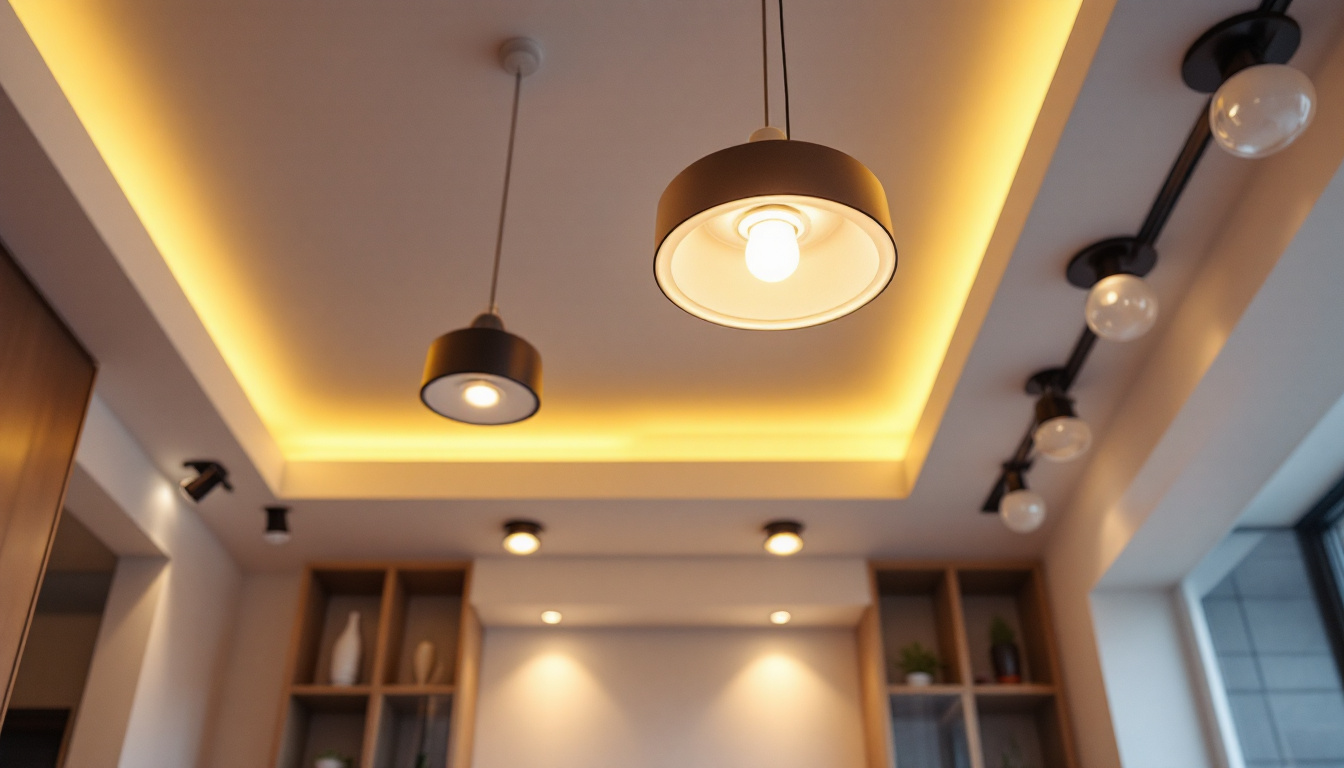
In the ever-evolving landscape of interior design and construction, lighting plays a pivotal role in enhancing aesthetics and functionality. For lighting contractors, understanding the nuances of ceiling lights can provide a significant competitive edge. This article delves into various aspects of ceiling lighting, exploring types, installation techniques, and the latest trends that can help contractors stand out in a crowded marketplace.
Ceiling lights serve as the primary source of illumination in any space, influencing both mood and functionality. They can transform a room, making it feel larger, cozier, or more inviting, depending on the design and placement. For contractors, recognizing the importance of ceiling lighting can lead to better recommendations for clients, ultimately enhancing customer satisfaction.
Ceiling lights are not merely functional; they are also a key design element. From sleek modern fixtures to ornate chandeliers, the right ceiling light can serve as a focal point in a room. Lighting contractors should stay informed about the latest designs and styles to provide clients with options that complement their interior decor.
Moreover, understanding how different types of lighting can affect the perception of space is crucial. For instance, recessed lighting can create an illusion of height, while pendant lights can draw the eye downward, making a room feel more intimate. The color temperature of the bulbs used can also play a significant role in setting the ambiance; warmer tones can create a cozy atmosphere, while cooler tones can evoke a sense of cleanliness and focus.
Beyond aesthetics, ceiling lights play a vital role in the functionality of a space. They can affect how well a room serves its purpose, whether it’s a kitchen, office, or living room. For example, bright, focused lighting is essential in workspaces, while softer lighting may be more appropriate for relaxation areas.
Contractors should evaluate the specific needs of each room and recommend ceiling lights that provide adequate illumination without overwhelming the space. This attention to detail can significantly enhance a contractor’s reputation and lead to more referrals. Additionally, the integration of smart lighting technology has revolutionized the way ceiling lights can be utilized. With the ability to control brightness and color via smartphone apps or voice commands, homeowners can easily adapt their lighting to suit various activities or moods, making the space even more versatile.
Furthermore, energy efficiency is an increasingly important consideration in lighting design. Utilizing LED fixtures not only reduces energy consumption but also extends the lifespan of the lighting, which can be a selling point for contractors. Educating clients about the benefits of energy-efficient options can lead to more sustainable choices and potentially lower utility bills, which is a win-win for both contractors and homeowners alike.
Understanding the various types of ceiling lights available is essential for lighting contractors. Each type has its unique advantages and applications, making it crucial to match the right fixture to the right space.
Recessed lighting, or can lights, is a popular choice for modern interiors. These fixtures are installed into the ceiling, creating a clean and unobtrusive look. They are ideal for providing general illumination and can be strategically placed to highlight specific areas or features within a room.
When recommending recessed lights, contractors should consider factors such as spacing, beam angle, and dimming capabilities. Proper installation is critical, as incorrect placement can lead to uneven lighting and diminished effectiveness. Additionally, the choice of trim style can influence the overall aesthetic; for example, baffle trims can help reduce glare, while reflector trims can enhance brightness. The use of LED recessed lights has also gained popularity due to their energy efficiency and longevity, making them a smart choice for both residential and commercial applications.
Pendant lights are versatile fixtures that hang from the ceiling, making them perfect for areas where task lighting is needed, such as over kitchen islands or dining tables. They come in various styles, from industrial to contemporary, allowing contractors to tailor their recommendations to the client’s aesthetic preferences.
When installing pendant lights, it’s essential to consider the height at which they hang. Too low can obstruct views and create a hazard, while too high can diminish their effectiveness. Proper placement enhances both functionality and design. Furthermore, pendant lights can be grouped in clusters for a more dramatic effect, allowing for creative arrangements that can serve as a focal point in a room. Selecting the right bulb type is also crucial, as it can affect the ambiance; warm white bulbs create a cozy atmosphere, while cooler tones can lend a more modern feel.
Chandeliers are often viewed as a statement piece in a room, adding elegance and sophistication. They are commonly used in dining rooms, entryways, and large living spaces. When selecting a chandelier, contractors should consider the scale of the room and the overall design theme.
Installation of chandeliers requires careful attention to weight and mounting. Ensuring that the ceiling can support the fixture is crucial, as is proper wiring to accommodate the chandelier’s electrical needs. Additionally, the choice of materials—ranging from crystal to metal—can dramatically alter the chandelier’s impact on the space. For instance, a crystal chandelier can reflect light beautifully, creating a sparkling effect, while a rustic wooden chandelier can add warmth and charm to a more casual setting. It’s also worth noting that dimmable chandeliers can enhance the versatility of the lighting, allowing homeowners to adjust the mood from bright and lively to soft and intimate, depending on the occasion.
Proper installation of ceiling lights is critical for both safety and performance. Lighting contractors must be well-versed in various installation techniques to ensure that fixtures are securely mounted and function as intended.
Before installation, contractors should assess the existing wiring and electrical systems. It’s essential to ensure that the circuit can handle the load of the new fixtures. This may involve upgrading the wiring or adding additional circuits to accommodate multiple lights.
Moreover, understanding local building codes and regulations is crucial. Compliance ensures safety and can prevent costly rework or fines. Contractors should stay updated on any changes in regulations that may affect their work.
Different types of ceiling lights require various mounting techniques. Recessed lights, for instance, need to be installed in a manner that ensures they sit flush with the ceiling. Pendant lights may require additional support, especially if they are larger or heavier.
Using the right mounting hardware and techniques is vital for ensuring the longevity and safety of the installation. Contractors should always follow manufacturer guidelines and best practices to achieve optimal results.
The lighting industry is constantly evolving, with new trends emerging regularly. Staying informed about these trends can provide lighting contractors with a competitive advantage and help them offer innovative solutions to clients.
Smart lighting has gained significant popularity in recent years, allowing homeowners to control their lighting through smartphones or voice-activated devices. This trend is not just about convenience; it also offers energy efficiency and customization options.
Lighting contractors should familiarize themselves with various smart lighting products and systems. Understanding how to integrate these solutions into existing electrical systems can set contractors apart from competitors who may not offer such advanced options.
With growing awareness of environmental issues, energy-efficient lighting solutions are more in demand than ever. LED fixtures, for instance, consume significantly less energy than traditional incandescent bulbs and have a longer lifespan.
Contractors should advocate for energy-efficient options to clients, highlighting the long-term cost savings and environmental benefits. This not only enhances the contractor’s reputation but also aligns with the values of many modern homeowners.
Customization is becoming increasingly popular in ceiling lighting. Homeowners are looking for unique fixtures that reflect their personal style and fit their specific needs. This trend allows contractors to showcase their creativity and expertise.
Offering customizable solutions, such as adjustable pendant heights or modular lighting systems, can attract clients looking for tailored options. Contractors who can provide personalized services are likely to build stronger relationships with their clients.
In a competitive market, effective marketing strategies are essential for lighting contractors to stand out. By leveraging various marketing channels, contractors can showcase their expertise and attract potential clients.
In today’s digital age, having a robust online presence is crucial. Contractors should invest in a professional website that showcases their services, portfolio, and client testimonials. A well-designed website can serve as a powerful marketing tool, helping to establish credibility and attract new clients.
Additionally, utilizing social media platforms can enhance visibility. Sharing project photos, lighting tips, and industry news can engage potential clients and position the contractor as an expert in the field.
Networking with other professionals in the construction and design industries can lead to valuable partnerships. Collaborating with interior designers, architects, and builders can create referral opportunities and expand the contractor’s reach.
Attending industry events and trade shows can also provide networking opportunities. Engaging with peers and potential clients can lead to new projects and collaborations that benefit all parties involved.
For lighting contractors, understanding the intricacies of ceiling lights is essential for success. By staying informed about the latest trends, mastering installation techniques, and employing effective marketing strategies, contractors can gain a competitive edge in the industry.
As the demand for innovative and efficient lighting solutions continues to grow, contractors who prioritize education and adaptability will be well-positioned to thrive. Embracing the evolving landscape of ceiling lighting can lead to increased client satisfaction and business growth.
Ready to elevate your lighting projects and outshine the competition? At LumenWholesale, we provide lighting contractors like you with the highest quality, spec-grade ceiling lights at prices that can’t be beaten. Say goodbye to local distributor markups and hello to our premium selection that meets rigorous industry standards. With free shipping on bulk orders, you can stock up on reliable, high-performance lighting solutions that will impress your clients and enhance your craftsmanship. Don’t compromise on quality or value—Wholesale Lighting at the Best Value is just a click away. Partner with LumenWholesale today and experience the difference quality lighting makes.

Discover how lighting rail systems can revolutionize your contracting business by enhancing efficiency and appeal in project bids.

Discover how lighting contractors can enhance their projects and boost efficiency by transitioning to LED replacements for fluorescent lights.

Discover essential insights into downlight lighting solutions tailored for contractors.

Discover how smart wall outlets can revolutionize your lighting projects by enhancing efficiency and control.